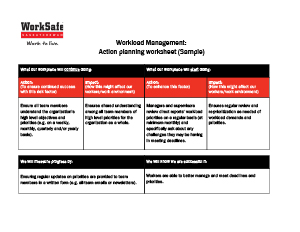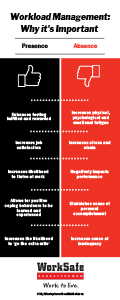 Workload management
Workload management
Includes a work environment where assigned tasks and responsibilities can be accomplished successfully within the time available, and where workers have the resources needed to do their job well.
“We have a weight to carry, and a distance we must go. We have a weight to carry, a destination we can’t know. We have a weight to carry and can put it down nowhere. We are the weight we carry, from there, to here, to there.” – Book of Counted Sorrows
Overview
What is workload management?
Workload management is present in a work environment where assigned tasks and responsibilities can be accomplished successfully within the time available. This is the risk factor that many working Canadians describe as being the biggest workplace stressor (e.g. having too much to do and not enough time to do it). It has been demonstrated that it is not just the amount of work that makes a difference, but also the extent to which workers have the resources (time, equipment, support) to do the work well.
An organization with good workload management would be able to state that:
- The amount of work workers are expected to do is reasonable for their positions.
- Workers have the equipment and resources needed to do their jobs well.
- Workers can talk to their supervisors about the amount of work they have to do.
- Workers’ work is free from unnecessary interruptions and disruptions.
- Workers have an appropriate level of control over prioritizing tasks and responsibilities when facing multiple demands.
FAQs
Action
Next steps: Committing to improved workload management
Workload Management is psychosocial factor 9 from CAN/CSA-Z1003-13/BNQ 9700-803/2013 – Psychological Health and Safety in the Workplace. Retrieved from: https://www.csagroup.org/article/cancsa-z1003-13-bnq-9700-803-2013-r2018/. See also Guarding Minds at Work (Samra et al.): Retrieved from https://www.guardingmindsatwork.ca/resources.




